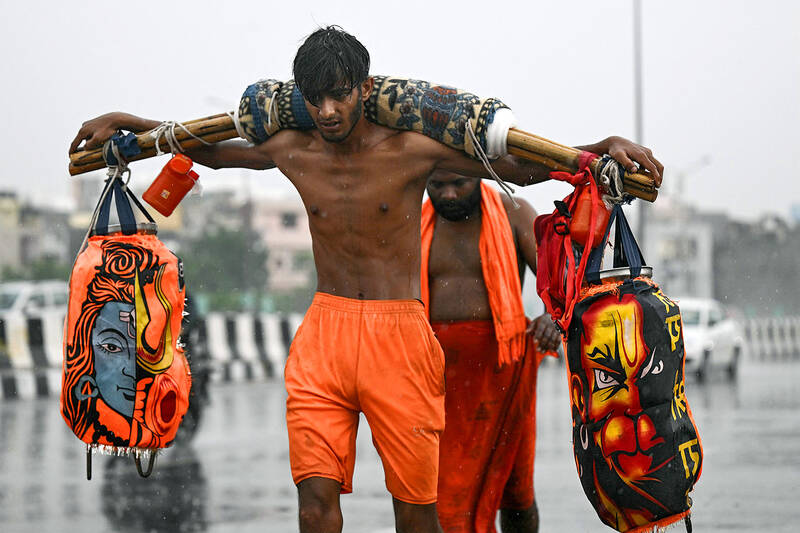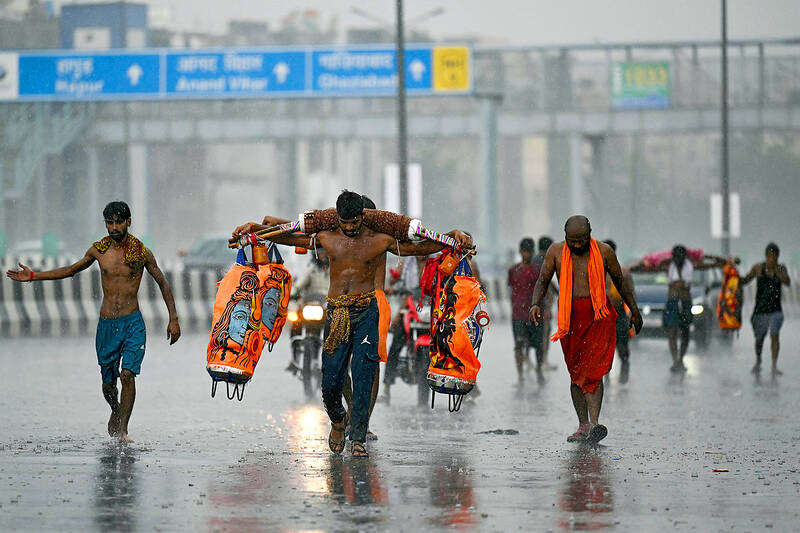The Hindu sacred month of Shravan honors the god of destruction Lord Shiva, and in northern India, it has become increasingly associated with mob violence by saffron-clad devotees.
Analysts say the increase in violence, and the muted response to stop it by the authorities, is a reaction to Prime Minister Narendra Modi’s Hindu-first politics.
Millions of people mark the month by trekking — some hundreds of kilometers — to collect holy water from the sacred Ganges river and carry it home to shrines, a celebration of the monsoon rains and new beginnings.

Photos: AFP
Many are young and poor men, dedicated to their deity — but also partying and taking a break from tough day-wage labor for a rare few weeks of fun, blaring loud music and smoking strong cannabis.
They are known as “Kanwarias,” after the bamboo poles across their shoulders they use to carry the heavy containers of sacred water.
This year, after the month-long pilgrimage started in late July, lawlessness surged.

Photo: AFP
The pilgrims have been caught multiple times on camera running riot — seen in videos shared widely on social media.
They include vandalizing a fuel station for being asked to stop smoking, violent road rage leaving passers-by grievously injured, and groups of Kanwarias fighting among themselves.
Pilgrims insist that hooliganism is restricted to a few stray incidents, blaming devotees who over-indulge in cannabis.
“There are rotten apples everywhere,” said 30-year-old Sachin Chawla, a Kanwaria puffing out clouds of fragrant smoke from a cigarette.
“Some people tend to get high and create a ruckus.”
‘SUBORDINATE TO THE PARTY’
Modi’s Hindu nationalist Bharatiya Janata Party (BJP) has boosted support for the travelers.
In the country’s most populous state Uttar Pradesh — whose chief minister is a hardline Hindu monk and key BJP leader — top government officials showered flower petals on the devotees from a helicopter.
That came days after pilgrims overturned a government security car.
The Modi government has “put across the message that the state is subordinate to the party in power”, said Sanjay Srivastava, an anthropologist teaching at SOAS University of London.
“This messaging seems to be clearly understood on the ground”.
Many devout Hindus are vegetarian during Shravan, and in several BJP-run states, local administrations ban meat on pilgrim routes.
But this year, some went further. Two state governments ordered restaurants to display the names of their owners, a rule that critics said was intended to divide restaurants by religion and target minority Muslims.
The order was later suspended by the Supreme Court.
ANCIENT TRADITION, NEW POPULARITY
Rickshaw-puller Kamal Kumar had spent two weeks walking nearly 200 kilometers carrying 70 liters of water in containers slung from a bamboo pole across his shoulders.
He had a day to go to his destination, a temple in the capital Delhi.
“I do it for Baba,” said the 20-year-old, using a term of endearment for Shiva. “Whatever I have, it is his doing.”
The number of devotees undertaking this journey is swelling by the year, according to official numbers.
Organizers estimate some 45 million people — more than the population of Canada — assembled in the holy Ganges-side city of Haridwar to collect water this year, a rise of 50 percent from 2017.
Most are poor, male, unemployed or work precarious menial jobs.
The offer of aid from a god has resounding appeal in “an uncertain economy with large-scale unemployment”, Srivastava said. “Everyone around me goes, so I also decided to go,” said Siddharth Kumar, a jobless 18-year-old who resides in a slum on the fringes of Delhi.
“I hope god does something for me and my family.”
Srivastava said more men now undertake the pilgrimage because there is a “broader climate of encouragement for participation in public religious activities.”
Popularity has been boosted within the context of “underemployed men’s activities, as well as a source seeking divine intervention for their precarious economic situation,” he added.
‘HOLIDAY’
The pilgrimage allows the working class to briefly “occupy the center stage,” said sociologist Ravinder Kaur, from the University of Copenhagen.
“It is as much an expression of vast class and caste inequalities that shape contemporary India,” she said. For many men, the journey is as much an opportunity to bond with friends.
Less dedicated devotees skip the walk, crowding into open trucks or on motorbikes, playing thumping music.
“I went with my friends from the neighborhood on our motorbikes,” said 23-year-old electrician Sunny Prajapati.
“Along with the chance to offer our prayers, we also get to go on a joy ride together — it is like a holiday.”

The canonical shot of an East Asian city is a night skyline studded with towering apartment and office buildings, bright with neon and plastic signage, a landscape of energy and modernity. Another classic image is the same city seen from above, in which identical apartment towers march across the city, spilling out over nearby geography, like stylized soldiers colonizing new territory in a board game. Densely populated dynamic conurbations of money, technological innovation and convenience, it is hard to see the cities of East Asia as what they truly are: necropolises. Why is this? The East Asian development model, with

June 16 to June 22 The following flyer appeared on the streets of Hsinchu on June 12, 1895: “Taipei has already fallen to the Japanese barbarians, who have brought great misery to our land and people. We heard that the Japanese occupiers will tax our gardens, our houses, our bodies, and even our chickens, dogs, cows and pigs. They wear their hair wild, carve their teeth, tattoo their foreheads, wear strange clothes and speak a strange language. How can we be ruled by such people?” Posted by civilian militia leader Wu Tang-hsing (吳湯興), it was a call to arms to retake

This is a deeply unsettling period in Taiwan. Uncertainties are everywhere while everyone waits for a small army of other shoes to drop on nearly every front. During challenging times, interesting political changes can happen, yet all three major political parties are beset with scandals, strife and self-inflicted wounds. As the ruling party, the Democratic Progressive Party (DPP) is held accountable for not only the challenges to the party, but also the nation. Taiwan is geopolitically and economically under threat. Domestically, the administration is under siege by the opposition-controlled legislature and growing discontent with what opponents characterize as arrogant, autocratic

Desperate dads meet in car parks to exchange packets; exhausted parents slip it into their kids’ drinks; families wait months for prescriptions buy it “off label.” But is it worth the risk? “The first time I gave him a gummy, I thought, ‘Oh my God, have I killed him?’ He just passed out in front of the TV. That never happens.” Jen remembers giving her son, David, six, melatonin to help him sleep. She got them from a friend, a pediatrician who gave them to her own child. “It was sort of hilarious. She had half a tub of gummies,